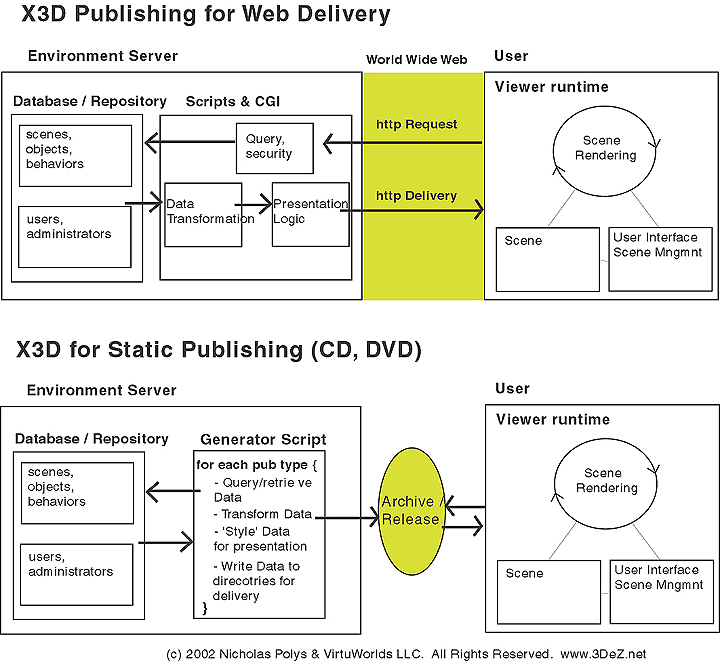Technology Concepts
- The Declarative paradigm:
portable data and applications
- Standards and the ecology
of tools
- The Scenegraph: Transformation
hierarchy & Behavior graph
- Custom objects encasupate
geometries and behaviors
Conceptually, each X3D application
is a 3D time-based space that contains graphic and aural objects that
can be loaded over a network and dynamically modified through a variety
of mechanisms. The semantics of X3D describe an abstract functional behaviour
of time-based, interactive 3D, multimedia information. X3D does not define
physical devices or any other implementation-dependent concepts (e.g.,
screen resolution and input devices). X3D is intended for a wide variety
of devices and applications, and provides wide latitude in interpretation
and implementation of the functionality. For example, X3D does not assume
the existence of a mouse or 2D display device.
Each X3D application:
· implicitly establishes a world coordinate space for all objects
defined, as well as all objects included by the application;
· explicitly defines and composes a set of 2D, 3D and multimedia
objects;
· can specify hyperlinks to other files and applications;
· can define object behaviours;
· can connect to external modules or applications via programming
and scripting languages.
The basic unit of the X3D run-time environment is the scene graph.
This structure contains all the objects in the system and their relationships.
Relationships are contained along several axes of the scene graph. The
transformation hierarchy describes the spatial relationship of
rendering objects. The behavior graph describes the connections
between fields and the flow of events through the system.
An X3D scene graph is a directed acyclic graph. Nodes
can contain specific fields with one or more children nodes which participate
in the hierarchy. These may, in turn, contain nodes (or instances of nodes).
This hierarchy of nodes is called the scene graph. Each arc in the graph
from A to B means that node A has a field whose value directly contains
node B. See [FOLEY] for details on hierarchical scene graphs.
Fields define
the persistent state of nodes, and values which nodes may send or receive
in the form of events. X3D supports four types of access to a node's fields:
· initializeOnly access, which allows content
to supply an initial value for the field but does not allow subsequent
changes to its value;
· inputOnly access, which means that the node
may receive an event to change the value of its field, but does not allow
the field's value to be read;
· outputOnly access, which means that the node
may send an event when its value changes, but does not allow the field's
value to be written; and
· inputOutput access, which allows full access
to the field: content may supply an initial value for the field, the node
may receive an event to change the value of its field, and the node may
send an event when its value changes.
Fields are specified for different
data types (single = SF, array = MF):
- 5.2 SFBool and MFBool
- 5.3 SFColor and
MFColor
- 5.4 SFColorRGBA
and MFColorRGBA
- 5.5 SFDouble and
MFDouble
- 5.6 SFFloat and
MFFloat
- 5.7 SFImage and
MFImage
- 5.8 SFInt32 and
MFInt32
- 5.9 SFNode and MFNode
|
- 5.10 SFRotation
and MFRotation
- 5.11 SFString and
MFString
- 5.12 SFTime and
MFTime
- 5.13 SFVec2d and
MFVec2d
- 5.14 SFVec2f and
MFVec2f
- 5.15 SFVec3d and
MFVec3d
- 5.16 SFVec3f and
MFVec3f
|
From Concepts:
Extensible 3D (X3D) Part 1: Architecture and base components ISO/IEC FDIS
19775-1:200x:
|

